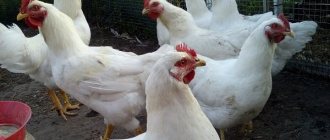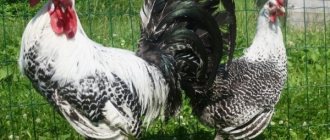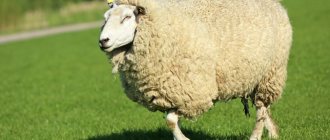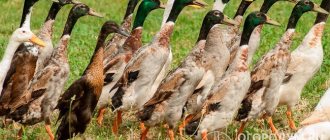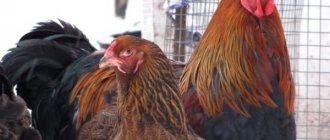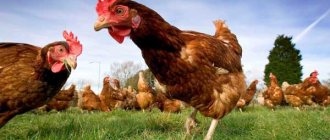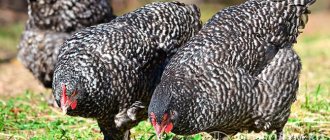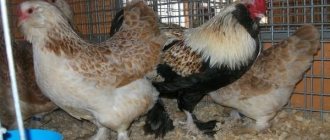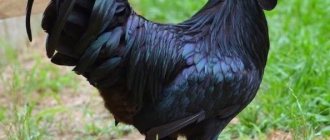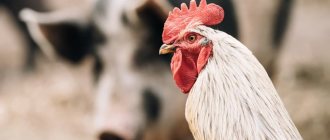The Zagorsk salmon breed of chickens attracted poultry farmers for their unique adaptability to harsh climatic conditions and productivity. The pleasant appearance of pets adds to their popularity.
Puberty occurs early, pullets begin to lay eggs at the age of 150–160 days
In private farmsteads, such inhabitants are common, second only to village crossbreeds. For new chicken farmers who want to get eggs and meat with a minimum of hassle, the Zagorsk breed of chickens will be the best option.
Chickens do not require a heated room and complex feed. Good immunity allows you to do without vaccinations in areas favorable to diseases.
Cockerels from two to four months grow quickly (three-month-old males reach 2 kg)
The peaceful nature becomes a plus for owners with children, who will definitely want to communicate with birds. There is no need to be afraid that the rooster will harm the baby, mistaking him for a threat to the harem.
History of breeding
Zagorsk chickens were bred at the Poultry Institute, which is located in Sergiev Posad (in those years called Zagorsk). The bird turned out to be highly productive and hardy. Even today it is the main pride of the institute.
Chickens, because of their qualities, have long gone beyond the territory of Russia.
Sometimes novice chicken breeders confuse them with representatives of the Faverol (salmon) breed, but these are completely different chickens.
The following breeds of birds were used to breed the breed:
- Yurlovskaya is vocal.
- Russian white.
- Rhode Island.
- New Hampshire.
As a result of complex breeding work, a chicken with light salmon-colored plumage was obtained. The plumage of hens and cockerels is different . Salmon only female. The rooster has black plumage (primary) with the addition of red and white feathers.
The Zagorsk salmon breed of chickens has become established and was registered in 1959 . The bird, thanks to its productivity and ease of keeping, has spread and today is the most common breed.
Most country yard crosses have some amount of salmon blood.
Subtleties of poultry breeding
Sexual maturity in laying hens occurs at 5.5 months, sometimes a little earlier. The first eggs of Zagorka are small, but after some time, when egg laying improves, the product corresponds to the description.
Individuals with deviations in appearance and plumage color are not allowed for breeding. For example, a rooster that has calico spots on its feathers is considered impure and is discarded. A common defect in Zagorsk chickens is the presence of an extra tooth on the comb .
A chicken family is formed at the rate of 1 male per 10–15 laying hens. Eggs for hens are taken from hens over 1 year old. When hatching chickens, there are usually no problems - the babies are born strong and healthy. Only 10% of young animals die in the first week of life. The chicks rapidly gain weight and are fully feathered by the age of one month.
Appearance
Cockerels differ from hens in plumage. Males have black flight feathers, while females have gray-cream feathers
Zagorsk salmon chickens have the following characteristics:
- The head is neat, round, small.
- The beak is yellow. Its end is slightly curved towards the bottom, which is why chickens resemble birds of prey.
- Earrings - noticeable, medium. The color is light red.
- The back is straight and long.
- Chest - chest protruding forward.
- The tail is small not only in chickens, but also in roosters.
- The comb is practically absent in the chicken, while in the rooster it is small, leaf-shaped, and erect.
Externally, the Zagorskaya chicken breed stands out noticeably among others, and it is not difficult for a poultry farmer to distinguish it.
About reviews
Private owners in villages and farmers who have a lot of chickens of this breed note that the birds are highly resistant to various diseases, are frost-resistant, and eat the food offered by their owners. If the food improves, then after some time the eggs become larger and the meat tastes better.
From childhood, roosters are clearly distinguishable from hens. The latter have a dark stripe down their back. When the chicks are 14 days old, they begin to grow feathers well. Those with dark wings are cockerels, and those with lighter wings are hens.
If there is a rooster or several in the flock, then it is 100% that they will fertilize all the hens. You can take any eggs and put them in an incubator, waiting for the chicks to hatch. Babies grow quickly. They are balanced and do not peck each other until they bleed.
Feedback from the owners is positive. Birds are smarter than many others, balanced. They eat what their owners offer them and quickly gain weight. Owners are pleased with the high egg production of laying hens.
Disadvantages include mischief, but it manifests itself due to the intelligence of the birds. It’s also bad that chickens are strong and fly high. If the fence is medium, then they will overcome it and go to their neighbors to feast on worms and grains, which will make them unhappy.
The owners note that adult chickens rarely get sick, and young chickens, if there is no virus in the chicken coop and eat well, survive 100%. With a good appetite, the chicks quickly gain weight. To avoid epidemics, the owner must periodically disinfect the chicken coop and remove excrement and change the water daily.
Productivity
Rooster carcass. Net weight 2 kg. Free range, not fattened
Poultry productivity is high. The weight of the carcass is about 2 kg 300 g. Record-breaking males produce a carcass of 3 kg. When fed with broiler feed, birds gain weight quickly, which makes it possible to fatten up excess roosters in a short time. The meat is tasty and is in demand among buyers . Thus, you can remove extra males from the herd and make money.
The egg production of chickens is indicative. They produce the largest eggs of any breed. The characteristic reflects the average weight of an egg, which is 70 g. In fact, with high-quality maintenance, the weight of eggs reaches 90 g, which is comparable to duck eggs.
The taste of the product is delicious. A laying hen produces up to 260 eggs per year .
You won’t find such chicken eggs in the store, since salmon chicken has been replaced from poultry farms by crosses, which produce up to 340 eggs per year.
The shell color ranges from light cream to light brown. The color of the shell does not affect the taste and composition of the contents.
Zagorsk salmon hens begin to lay eggs at 4.5–5.5 months. For the first 2–3 months, the eggs are not large . A decrease in egg size also occurs in older birds. Salmon are kept on farms for 3–4 years, after which they are released for meat, as egg production is greatly reduced.
Advantages and disadvantages
Zagorsk salmon chickens have many advantages over other breeds.
Advantages:
- grow quickly;
- unpretentious and active;
- peaceful disposition;
- high egg production;
- They can be either laying hens or brood hens.
The only disadvantage of the breed can be called purely decorative elements: these birds do not have a collar or beard.
Despite his calm nature, the rooster is able to protect his chickens from rats and other rodents that have entered the chicken coop.
Pedigree chicken
Hatching instinct
Zagorsk hens have a highly developed maternal instinct. They can hatch other people's chicks, including chickens of a different breed. The brooding instinct is manifested in the fact that salmon hens happily sit on eggs. Therefore, they are rightfully considered not only the best laying hens, but also one of the most caring hens.
Molting and problems with egg production
During the colder months, hens may temporarily stop laying eggs. Closer to spring, their egg production is restored.
Chickens do not lay eggs during the molting period, which begins in mid-autumn and passes quickly. The plumage changes completely in 21 days. At this time, birds should not be allowed outside to prevent them from freezing. Chickens over 4–5 years old stop laying eggs.
In all these cases, vitamin and mineral supplements should be included in the birds' diet.
The rooster is able to protect his flock
Temperament
The salmon breed is easy-going and can be kept in a common poultry house without any problems. If there are several roosters in the herd, fights sometimes break out between them, but they extremely rarely lead to bloodshed and usually, after jostling a little, the rivals disperse.
Even with roosters of other breeds, males quickly find a common language, avoiding serious clashes.
The bird is energetic and can climb over fences up to 2 meters high. They escape especially often if beds with tasty plants come into their field of vision.
If salmon escape and get to the plantings, they quickly tear them out and dig up the beds in search of worms. Birds' feet are strong, and they destroy the root system of plants. In order to prevent escape and destruction of the beds, the fence of the walking area is made from 2 meters and preferably with a small roof.
To prevent undermining, a concrete strip is installed around the perimeter .
Roosters are not dangerous to the owner. The male can attack strangers if they frighten his harem. The male easily drives away the rats and thereby prevents their appearance in the yard.
Frequent illnesses
Representatives of the breed are distinguished by strong immunity, therefore they are immune to most pathologies of poultry. The main danger for them are viral and bacterial diseases, which mainly develop under unsanitary living conditions and consumption of low-quality food.
The most common diseases in salmon fish are:
- Coccidiosis with damage to the digestive organs and liver. The pathogenic agent is a single-celled coccidia. The parasite enters the body through food. Infection most often occurs after walking in warm and rainy weather. The main symptoms are lack of appetite, lethargy, and diarrhea. The disease is contagious and dangerous; chicken mortality is 100%.
- Mycoplasmosis with damage to the respiratory system. Mycoplasma bacteria are transmitted by airborne droplets. Infected birds have difficulty breathing and mucus accumulates in the nostrils. Death occurs in 10% of cases.
- Paratyphoid fever is an intestinal infection caused by the bacterium Amiranella Salmonella. The chickens begin to drink a lot and refuse to eat. Their eyes water profusely and their eyelids stick together. The pathological process develops quickly, accompanied by toxicosis, damage to the intestines and lungs. Infection in a flock occurs quickly.
- Neurolymphomatosis. The causative agents are microorganisms from the herpesvirus family. The infection is transmitted by rodents and darkling beetles, and sometimes enters the bird's body through the products of the slaughterhouse. When infected, animals gradually lose motor activity, and tumors appear on their skeleton and skin. The pathology cannot be treated.
Under poor living conditions, chickens are often exposed to infection with ecto- and endoparasites. The former live on the surface of the body, the latter penetrate into the body. If these harmful organisms are detected, it is necessary to disinfect the birds, thoroughly clean the premises and contact a veterinarian to prescribe treatment procedures.
Content Features
The bird is distinguished by its unpretentiousness , which applies to everything - feeding, care and temperature. Full stress resistance simplifies maintenance.
In regions with particularly low temperatures, the poultry barn still needs to be heated. In the South and in the middle zone, there will be enough insulated premises in which there will be no drafts.
It is necessary to ventilate the poultry house in winter for 10 minutes daily to remove gases rising from rotting droppings.
If it is necessary not to disturb the silence at night, in order to prevent roosters from crowing, ensure darkness in the barn. Shutters on the windows and a closed door will not let in the first rays that awaken the feathered singers.
Care
Bird care is standard . The chicken coop is cleaned in the spring, completely replacing the bedding, and the floor and walls are covered with slaked lime. On the walk, baths with sand and ash are set up to cleanse skin parasites. It is also necessary to place additional feeders with fine gravel or coarse sand, the ingestion of which will improve the bird’s digestion.
Equipment should be washed and disinfected at least once a month. Manganese or hydrogen peroxide is used for processing. Chlorhexidine, a cheap and strong antiseptic, is also suitable.
Vaccinations for chickens are necessary only in areas unfavorable for diseases or in flocks of more than 100 birds, when in crowded conditions the risk of infections increases significantly.
Feeding
Zagorsk salmon are able to feed themselves, they eat a lot of bulky feed, and therefore are cheap.
Chickens are not picky about food . They are fed without any problems even with uncrushed corn, which they easily swallow.
In summer, Zagorsk chickens willingly eat pasture. They collect insects, eat greens and fruits. When there are fruit trees, it is useful to give your pets their fruits. Salmon beaks are strong and can easily peck apples, making slicing them unnecessary. The bird is active, and fussing with the delicacy will appeal to it.
Water is poured into the drinking bowl at the rate of 200 ml per head plus 300 ml for spillage and evaporation . The contents of the drinking bowl should be changed in the morning and evening, just like other birds.
When there is a risk of intestinal infections, a weak solution of manganese is given to drink instead of water.
Breeding
The incubation instinct is highly developed, and the female easily sits on the nest . Hens hatch chicks and raise them. Natural mortality accounts for 10% of the brood.
The need for an incubator is only for the primary production of chickens through eggs.
Acquisition
Zagorsk salmon chickens can be bought at the Gene Pool - in Moscow and St. Petersburg. Birds from Moscow are similar to broilers - strong and massive. The breed is also sold by private traders, but it is worth choosing trusted poultry farmers.
The price for eggs for incubation varies from 90 rubles, and for chickens - from 150 rubles.
To purchase healthy chickens you need to pay attention to the following:
- It is advisable to have the opportunity to look at the adult animals of the farm and the conditions of their detention.
- If gray or chestnut spots are visible in the chest area of the chickens, then they are not purebred. Such birds cannot be crossed with other breeds, because the result cannot be predicted.
- Healthy chickens are active, peck at the food offered, and respond to tapping. Lethargy, indifference to food and lack of response to sounds indicate illness.
- If chickens have: bare areas that should be covered with fluff, any discharge from the eyes, a protruding belly, bleeding - this indicates serious health problems.
Raising Zagorsk salmon chickens can bring a stable income. The breed does not require special housing conditions and tolerates changes well and without loss of productivity. The rapid sexual maturation of chickens and weight gain in cockerels ensures the production of meat and eggs in a short time, which pays off the cost of their purchase.
0
0
Copy link
Raising chickens
If the hen raises the chicks herself, then no intervention is required from the owner.
In raising hatchery young animals there are no differences from the standard scheme. Chicks require warmth and frequent feeding. Salmon fledge quickly, which reduces the time they are kept warm.
Photo
In the first photo you see chickens of the Zagorsk salmon breed, representatives of which are sitting on a comfortable stick in the chicken coop:
This is the same chicken coop, only the right part has been removed. You see that they love to sit on a stick:
In this case, a poultry house was removed, where chickens walk on the ground with sawdust:
Small bird house:
And in this photo you see individuals on a production scale:
Of course, it won’t be possible without chickens’ favorite activity—searching for food in the ground:
Photo gallery
Diet
As noted earlier, this is a fairly unpretentious chicken in terms of nutrition. They happily eat even uncrushed corn and other grains.
In the summer, chickens are excellent at self-grazing, which significantly saves their maintenance. Chickens love insects, fresh grass, vegetables, fruits, etc.
We also recommend reading: Description of the Plymouthrock chicken breed
In order for a bird to be as productive as possible, its diet must necessarily consist of the following components:
- Grain. This is the basis of the diet. They should be given both crushed and whole. To increase egg production, it is recommended to feed the bird sprouted wheat.
- Mash. It is advisable to give them in the afternoon, at lunch. The mashes are valuable because they contain all the necessary elements for the normal growth of poultry. Mash can be prepared either with meat broth or with plain water. Cereals, vegetables, table salt, etc. are added to the mash.
- Sources of calcium. It is very important not to forget about sources of calcium. They are necessary for the formation of a normal egg shell. If there is a lack of calcium, chickens may produce eggs with thin or soft shells, or without them at all. The most popular sources of calcium are: chalk, crushed shell rock and crushed eggshells. As for eggshells, in the case of such a source of calcium you need to be careful, because if the chicken recognizes the shell in the ground substance, she may begin to peck at her eggs. But with daily use of chalk, it may stick together and clog the gastrointestinal tract. Therefore, crushed shell rock is the best option.
- Vegetables.
- Fresh grass.
- Salt.
- Bone and fish meal.
In addition, do not forget about clean water, which must be available for 24 hours.
Feeding
To feed Zagorsk chickens, you can use ready-made mixed feed, but you should not overuse it - it can cause obesity in the birds. You can add crushed and whole sprouted grains (wheat, millet, barley) to the diet; vegetable supplements, herbs and protein supplements are required.
- Stern
- Recipes
- Supplements
Compound feed pk-1
Description of food for egg breeds. Instructions for feeding laying hens
Read
Compound feed pk-2 and pk-3
Mineral and vitamin compositions, feeding standards
Read
Compound feed pk-4
Used to feed laying hens aged 15-17 weeks
Read
Compound feed pk-5
Composition and instructions for feeding broiler chickens
Read
Purina® Pro
Important differences from the previous line, application patterns Start, Growth, Finish
Read
Barley and wheat for laying hens
Germination and steaming of barley and wheat for chickens: how to do it correctly and how to give it to laying hens
Read
Wheat for broilers
Rules for feeding broiler chickens with wheat. Dosage for chickens from the second day of life and adult birds
Read
Mash
Making mash for broilers at home
Read
Rice and buckwheat
How and in what form you can use rice and buckwheat to feed chickens. Standards for adult birds and chickens
Read
Bread
What kind of bread can you feed chickens and how to do it correctly
Read
Fish
The product is given in limited quantities: overfeeding can cause serious harm to the bird
Read
Chalk
Chalk as a food additive for chicken feed. Feeding standards for chickens, young animals and laying hens
Read
Meat and bone meal
Meat and bone meal is a mandatory additive for feeding chickens, containing protein and fats of animal origin.
Read
Fish fat
How to give fish oil to chickens, layers and broilers. What are the benefits of the drug and are there any contraindications?
Read
Limestone
Limestone (dolomite) flour in the diet of chickens. Advantage over chalk and feed shell
Read
Salt
Daily dosage of salt for adult birds and young animals and cases of unwanted use
Read
Description of Zagorsk salmon chickens
Roosters differ significantly from chickens in color. Females have almost solid salmon plumage, only the brown back is different. The main decoration of males is a bright, white-silver mane; roosters have a black tail and belly, and their back is reddish-brown and pockmarked. Approved breed standards:
- small, rounded head;
- eyes yellowish-red;
- strong, wide, straight back;
- body slightly elongated;
- medium length tail;
- the wings are strong and strong, pressed tightly to the body;
- the comb is medium-sized, leaf-shaped with 4 or 5 teeth, straight;
- legs bare, light yellow;
- the comb, lobes and beard are red;
- the beak is medium-sized, slightly curved, yellow, sometimes dark spots may appear at the base.
Breed violations:
- calico color of rooster plumage and brown, gray feathers or spots on the chest;
- short, narrow and weak body;
- underdeveloped, hard abdomen in females;
- flat chest and sharp back of the body;
- white earlobes;
- short or long legs;
- lack of red feathers on the back and wings;
- absence of white feather shaft in chickens.
Zagorsk chickens are not an autosex breed, however, the sexual characteristics of chickens are noticeable already at one day of age. Males have a light yellow, uniform plumage color, while females have a pronounced pinkish-gray spot or several stripes on their backs. Clearer differences between hens and roosters are noticeable already on the 10th day of life.
Performance Metrics
The breed is meat-and-egg, chickens weigh from 2 to 2.7 kilograms, roosters - no more than 3.7. At the age of 90 days, the weight of males fluctuates between 2 kilograms. Birds reach sexual maturity around six months; a chicken produces from 180 to 220 eggs per year. The weight of the first eggs is about 42–45 grams, then increases to 60–85 grams. The shell is cream or cocoa colored.
Attention! The pullet should not be overfed, otherwise the egg production period will come later than usual. Chickens lay eggs well in winter; a slight decrease in egg production is observed only during molting, which can be accelerated with special nutrition. The eggs and meat are tasty, the flesh is dark red, quite soft, sometimes it is compared to beef
The eggs and meat are tasty, the flesh is dark red, quite soft, sometimes it is compared to beef
Chickens lay eggs well in winter; a slight decrease in egg production is observed only during molting, which can be accelerated with special nutrition. The eggs and meat are tasty, the flesh is dark red, quite soft, sometimes it is compared to beef.
Character of the breed
Females are calm, not fussy, but at the same time active and mobile, very curious. The brooding instinct is weak, the hens sit on the eggs, but quickly lose interest in nesting. Roosters cannot be called aggressive, they do not attack people, but they monitor and protect their flock. Males love to scream.
Adults are not always friendly towards young animals, chickens are a little timid, chickens take advantage of this and drive them away from food. When relocating young animals to older flocks, it is better to place more containers with feed in the chicken coop. Roosters are very active; when forming a flock of 8–15 females, they leave one boy, but it is advisable to keep a spare one (separate from the family).
Pros and cons of the breed
Over the 60 years of its existence, Zagorsk salmon chickens have won the love and recognition of many farmers. The bird stands out for its considerable list of advantages:
- endurance, chickens are not afraid of either heat or cold;
- unpretentiousness in food;
- molting takes place without severe loss of egg production, chickens quickly fledge;
- excellent immunity to diseases;
- high egg fertility and chicken survival rate;
- calm character.
The breed has no serious disadvantages. However, some farmers do not like the ability of Zagorsk chickens to fly over two-meter fences, walk through neighbors' yards and roost in the crowns of garden trees. The very impressive weight does not at all prevent the bird from conquering heights.
How are things going with motherhood?
As you know, very often in the process of breeding a new cross, chickens lose some of their advantages, acquiring new ones in return. But, despite the manipulations of scientific breeders, the mother still retained her maternal qualities, although they were not fully developed.
Mothers of this breed do not need an incubator to fulfill the great mission of procreation.
Where can I buy in Russia?
Where the Zagorsk breed was bred, it is sold. Successfully. And, basically, not to private individuals, although the details need to be clarified. After so many decades, the Institute was reorganized into Genofond LLC, and its employees continue to do the same (favorite!) business: selection and raising of domestic animals, in particular chickens.
For those interested, we publish contact information:
Address: Russia, Moscow region, Sergiev Posad, st. Maslieva, 44. Contact numbers (faxes); +7 (496) 546-19-20.
Breeding work to improve the breed is carried out by the Federal State Unitary Enterprise "Gene Pool" of the Russian Agricultural Academy, located in St. Petersburg.
Address: 196625, St. Petersburg, RP Shushary, temporary storage warehouse Detskoselsky, territory of VNIIGRZh. Contact phone: +7 (812) 476-85-56.
Description
As already noted, the Zagorsk breed is endowed with pronounced sexual dimorphism. A cockerel and a hen can be distinguished even on the first day of their life.
Appearance
Adult roosters have nothing to do with the salmon color. The black and white color of the males corresponds to the breed. If they show calico or any other coloring, this indicates impurities that are present in a particular bird. Roosters are strong, muscular, with bright, beautiful combs. But they cannot boast of long tails, since they have a short, protruding, fluffy tail.
In addition to the difference in color, chickens differ from roosters in size and more modest appearance. The hen looks like this:
- the body is quite large, with an elongated body and well-developed muscle mass;
- wide chest protruding forward;
- the back is flat, straight;
- small head with orange eyes;
- short bushy tail;
- the comb and earrings are small but bright;
- the plumage is thick and dense.
Character
The birds are very energetic and can fly over a two-meter fence. And if they succeed, you can forget about the harvest in the beds - everything is raked by their powerful paws. But the Zagorsk people have a peaceful and accommodating character. Chickens easily accept individuals of another breed. Roosters rarely even fight for a harem.
This breed is convenient for families with children, since there is no need to worry about the aggressive behavior of roosters towards children. Hens are good brood hens; this feature is often used to lay eggs of other breeds.
